Assessment of Variation in Land Use/Land Cover (LULC) and Greening Through the Expansion of Algaroba (Neltuma juliflora) in the Semi-Arid Brazilian Coast
Abstract
1. Introduction
2. Materials and Methods
2.1. Study Area
2.2. Methodological Procedure
3. Results
4. Discussion
4.1. Analysis of Use and Occupation
4.2. Implications of the Species Neltuma juliflora in the Study Area
4.3. Rural–Urban Fringe and the Introduction of Algaroba in APADR
5. Conclusions
Author Contributions
Funding
Data Availability Statement
Acknowledgments
Conflicts of Interest
References
- Cunha, L.H.; Gomes, R.A. The trajectory of algaroba in the northeastern semi-arid region: Political and scientific dilemmas. Raízes J. Soc. Econ. Sci. 2012, 32, 72–95. [Google Scholar] [CrossRef]
- Ribaski, J.; Drumond, M.A.; Oliveira, V.R.D.; Nascimento, C.E.D.S. Algaroba (Prosopis juliflora): A Tree with Multiple Uses for the Brazilian Semi-Arid Region; EMBRAPA: Colombo, Brazil, 2009; pp. 1–7. Available online: https://www.infoteca.cnptia.embrapa.br/infoteca/bitstream/doc/661908/1/CT240Prosopis.pdf (accessed on 13 September 2025).
- Patnaik, P.; Abbasi, T.; Abbasi, S.A. Prosopis (Prosopis juliflora): Blessing and bane. Trop. Ecol. 2017, 455–483. Available online: https://www.researchgate.net/publication/322682224_Prosopis_Prosopis_juliflora_Blessing_and_bane (accessed on 17 September 2025).
- Trenchard, L.J.; Harris, P.J.; Smith, S.J.; Pasiecznik, N.M. Review of ploidy in the genus Prosopis (Leguminosae). Bot. J. Linn. Soc. 2008, 156, 425–438. [Google Scholar] [CrossRef]
- Câmara, A.C.L.; Costa, N.D.A.; Riet-Correa, F.; Afonso, J.A.B.; Dantas, A.F.; Mendonça, C.L.D.; Souza, M.I.D. Spontaneous poisoning in cattle by mesquite beans, Prosopis juliflora (Leg. Mimosoideae) in Pernambuco. Pesqui. Veterinária Bras. 2009, 29, 233–240. [Google Scholar] [CrossRef]
- Santos, J.P.S.; Diodato, M.A. History of algaroba implementation in Rio Grande do Norte. Braz. For. Res. 2017, 37, 201–212. [Google Scholar] [CrossRef]
- Mwangi, E.; Swallow, B. Invasion of Prosopis juliflora and Local Livelihoods: Case Study from the Lake Baringo Area of Kenya; ICRAF Working Paper no. 3; World Agroforestry Centre: Nairobi, Kenya, 2005; pp. 1–66. [Google Scholar] [CrossRef]
- Knüsel, S.; Conedera, M.; Rigling, A.; Fonti, P.; Wunder, J. A tree-ring perspective on the invasion of Ailanthus altissima in protection forests. For. Ecol. Manag. 2015, 354, 334–343. [Google Scholar] [CrossRef]
- Eschen, R.; Bekele, K.; Mbaabu, P.R.; Kilawe, C.J.; Eckert, S. Prosopis juliflora management and grassland restoration in Baringo County, Kenya: Opportunities for soil carbon sequestration and local livelihoods. J. Appl. Ecol. 2021, 58, 1302–1313. [Google Scholar] [CrossRef]
- Huang, C.Y.; Asner, G.P. Applications of remote sensing to alien invasive plant studies. Sensors 2009, 9, 4869–4889. [Google Scholar] [CrossRef]
- He, K.S.; Rocchini, D.; Neteler, M.; Nagendra, H. Benefits of hyperspectral remote sensing for tracking plant invasions. Divers. Distrib. 2011, 17, 381–392. [Google Scholar] [CrossRef]
- Bradley, B.A. Remote detection of invasive plants: A review of spectral, textural and phenological approaches. Biol. Invasions 2014, 16, 1411–1425. [Google Scholar] [CrossRef]
- Rocchini, D.; Andreo, V.; Förster, M.; Garzon-Lopez, C.X.; Gutierrez, A.P.; Gillespie, T.W.; Hauffe, H.C.; He, K.S.; Kleinschmit, B.; Mairota, P.; et al. Potential of remote sensing to predict species invasions: A modeling perspective. Prog. Phys. Geogr. Earth Environ. 2015, 39, 283–309. [Google Scholar] [CrossRef]
- Peerbhay, K.; Mutanga, O.; Lottering, R.; Ismail, R. Mapping Solanum mauritianum plant invasions using WorldView-2 imagery and unsupervised random forests. Remote Sens. Environ. 2016, 182, 39–48. [Google Scholar] [CrossRef]
- Pegado, C.M.A.; Andrade, L.A.D.; Félix, L.P.; Pereira, I.M. Effects of the biological invasion of mesquite: Prosopis juliflora (Sw.) DC. on the composition and structure of the shrub-tree stratum of the caatinga in the municipality of Monteiro, PB, Brazil. Acta Bot. Bras. 2006, 20, 887–898. [Google Scholar] [CrossRef]
- Andrade, L.A.D.; Fabricante, J.R.; Oliveira, F.X.D. Impacts of the invasion of Prosopis juliflora (sw.) DC. (Fabaceae) on the shrub-tree stratum in Caatinga areas in the State of Paraíba, Brazil. Acta Sci. Biol. Sci 2010, 32, 249–255. [Google Scholar] [CrossRef]
- Mendonça, M.F.; Pedroso, P.M.; Pimentel, L.A.; Madureira, K.M.; Macêdo, J.T.; D’sOares, C.S.; Silva, A.W.; Peixoto, T.C. Epidemiological aspects of natural poisoning by Prosopis juliflora in ruminants in semiarid areas of the state of Bahia, Brazil, invaded by the plant. Pesqui. Veterinária Bras. 2020, 40, 501–513. [Google Scholar] [CrossRef]
- Vilà, M.; Espinar, J.L.; Hejda, M.; Hulme, P.E.; Jarošík, V.; Maron, J.L.; Pergl, J.; Schaffner, U.; Sun, Y.; Pyšek, P. Ecological impacts of invasive alien plants: A meta-analysis of their effects on species, communities and ecosystems. Ecol. Lett. 2011, 14, 702–708. [Google Scholar] [CrossRef] [PubMed]
- Linders, T.E.W.; Schaffner, U.; Eschen, R.; Abebe, A.; Choge, S.K.; Nigatu, L.; Mbaabu, P.R.; Shiferaw, H.; Allan, E. Direct and indirect effects of invasive species: Biodiversity loss is a major mechanism by which an invasive tree affects ecosystem functioning. J. Ecol. 2019, 107, 2660–2672. [Google Scholar] [CrossRef]
- Howari, F.M.; Sharma, M.; Nazzal, Y.; El-Keblawy, A.; Mir, S.; Xavier, C.M.; Salem, I.B.; Al-Taani, A.A.; Alaydaroos, F. Changes in the Invasion Rate of Prosopis juliflora and Its Impact on Depletion of Groundwater in the Northern Part of the United Arab Emirates. Plants 2022, 11, 682. [Google Scholar] [CrossRef]
- Gao, J.; Kennedy, D.M.; Konlechner, T.M. Coastal dune mobility over the past century: A global review. Prog. Phys. Geogr. Earth Environ. 2020, 44, 814–836. [Google Scholar] [CrossRef]
- Wang, L.; Qiu, Y.; Han, Z.; Xu, C.; Wu, S.-Y.; Wang, Y.; Xu, Z. Climate, topography and anthropogenic effects on desert greening: A 40-year satellite monitoring in the Tengger Desert, northern China. Catena 2022, 209, 105851. [Google Scholar] [CrossRef]
- Scarano, F.R. Structure, function and floristic relationships of plant communities in stressful habitats marginal to the Brazilian Atlantic rainforest. Ann. Bot. 2002, 90, 517–524. [Google Scholar] [CrossRef] [PubMed]
- IDEMA/RN. Atlas for the Promotion of Sustainable Investment in Rio Grande do Norte. 2014. Available online: http://adcon.rn.gov.br/ACERVO/idema/Conteudo.asp?TRAN=ITEM&TARG=1360&ACT=null&PAGE=0&PARM=null&LBL=Socioecon%C3%B4micos (accessed on 1 October 2025).
- Faustino, S.J.B. Community Perception in the Participatory Process of Creating and Managing the Dunas do Rosado-RN Environmental Protection Area. Master’s Thesis, Federal Rural University of the Semi-arid Region, Mossoró, Brazil, 2022. [Google Scholar] [CrossRef]
- Rio Grande do Norte (State). DECREE No. 27,695/2018. Published in the Official Gazette of the State of Rio Grande do Norte. 2018. Available online: http://adcon.rn.gov.br/ACERVO/gac/DOC/DOC000000000172319.PDF (accessed on 15 September 2025).
- Diniz, M.T.M.; Pereira, V.H.C. Climatology of the state of Rio Grande do Norte, Brazil: Active atmospheric systems and climate type mapping. Goiano Geogr. Bull. 2015, 35, 488–506. [Google Scholar] [CrossRef]
- IDEMA/RN. Socio-Economic Studies. Profile—Your Municipality. Porto do Mangue. Available online: http://www.idema.rn.gov.br (accessed on 1 October 2025).
- Dantas, E.P.; Medeiros, V.C.; Cavalcante, R. Mapa Geológico do Estado do Rio Grande do Norte. Recife: Serviço Geológico do Brasil—CPRM. 2021. Available online: https://rigeo.sgb.gov.br/handle/doc/22401 (accessed on 4 September 2025).
- Rabelo, T.O.; Diniz, M.T.M.; de Araújo, I.G.D.; de Oliveira Terto, M.L.; Queiroz, L.S.; Araújo, P.V.d.N.; Pereira, P. Risk of Degradation and Coastal Flooding Hazard on Geoheritage in Protected Areas of the Semi-arid Coast of Brazil. Water 2023, 15, 2564. [Google Scholar] [CrossRef]
- Diniz, M.T.M.; de Oliveira, G.P.; Maia, R.P.; Ferreira, B. Geomorphological mapping of the state of Rio Grande do Norte. Braz. J. Geomorphol. 2017, 18, 689–701. [Google Scholar] [CrossRef]
- Diniz, M.T.M.; Terto, M.L.D.O.; da Silva, F.E.B. Assessment of the geomorphological heritage of the Costa Branca area, a potential geopark in Brazil. Resources 2023, 12, 13. [Google Scholar] [CrossRef]
- LAGGEF—Laboratory of Geoprocessing and Physical Geography (UFRN). SPOT-5 PSM Image (Spatial Resolution of 2.5 m) Caicó, 2025. Satellite Image: Color. Belonging to the LAGGEF/UFRN Collection. Available online: https://regards.cnes.fr/user/swh/modules/60 (accessed on 16 November 2025).
- Ministry of the Environment. Aquatic Biodiversity and Fisheries Resources Management. Overview of Coastal and Marine Ecosystem Conservation in Brazil; MMA/SBF/GBA: Brasília, Brazil, 2010; p. 148. Available online: https://www.marinha.mil.br/secirm/sites/www.marinha.mil.br.secirm/files/mma-205_publicacao27072011042233.pdf (accessed on 2 September 2025).
- Mbaabu, P.R.; Ng, W.-T.; Schaffner, U.; Gichaba, M.; Olago, D.; Choge, S.; Oriaso, S.; Eckert, S. Spatial evolution of Prosopis invasion and its effects on LULC and livelihoods in Baringo, Kenya. Remote Sens. 2019, 11, 1217. [Google Scholar] [CrossRef]
- CBERS—China-Brazil Earth Resources Satellite. EMBRAPA. Available online: https://www.embrapa.br/satelites-de-monitoramento/missoes/cbers (accessed on 2 September 2025).
- QGIS Development Team. QGIS Geographic Information System (Version 3.34) [Software]. Open Source Geospatial Foundation. 2024. Available online: https://qgis.org (accessed on 15 April 2025).
- Google Earth Pro. Google Earth Pro (Version 7.3) [Computer Software]. Google LLC. 2024. Available online: https://earth.google.com/ (accessed on 16 November 2025).
- National Institute for Space Research—INPE. INPE Catalog. 2025. Available online: https://www.dgi.inpe.br/catalogo/explore (accessed on 2 September 2025).
- Dzikiti, S.; Schachtschneider, K.; Naiken, V.; Gush, M.; Moses, G.; Le Maitre, D.C. Water relations and the effects of clearing invasive Prosopis trees on groundwater in an arid environment in the Northern Cape, South Africa. J. Arid. Environ. 2013, 90, 103–113. [Google Scholar] [CrossRef]
- Tundia, K.; Ghosh, S.; Chinnasamy, P. Influences of Prosopis juliflora on groundwater resources in Gujarat. J. Hydrol. 2025, 662, 133993. [Google Scholar] [CrossRef]
- Shiferaw, H.; Alamirew, T.; Dzikiti, S.; Bewket, W.; Zeleke, G.; Schaffner, U. Water use of Prosopis juliflora and its impacts on catchment water budget and rural livelihoods in Afar Region, Ethiopia. Sci. Rep. 2021, 11, 2688. [Google Scholar] [CrossRef]
- Araújo, C.P.D.; Amaral, R.F.; do Nascimento Araújo, P.V. Granulometry and morphometry of coastal surface sediments: The interdune lagoon complex of the Jenipabu APA, Rio Grande do Norte, Brazil. HOLOS 2020, 6, 1–18. [Google Scholar] [CrossRef]
- Pinto-Cruz, C.; Molina, J.A.; Barbour, M.; Silva, V.; Espírito-Santo, M.D. Plant communities as a tool in temporary ponds conservation in SW Portugal. Hydrobiologia 2009, 634, 11–24. [Google Scholar] [CrossRef]
- Zacharias, I.; Dimitriou, E.; Dekker, A.; Dorsman, E. Overview of temporary ponds in the Mediterranean region: Threats, management and conservation issues. J. Environ. Biol. 2007, 28, 1–9. Available online: https://www.jeb.co.in/journal_issues/200701_jan07/paper_01.pdf (accessed on 27 September 2025). [PubMed]
- Byalt, V.V.; Korshunov, M.V. Distribution of Invasive Species Prosopis juliflora (Mimosaceae) in Fujairah (UAE). Russ. J. Biol. Invasions 2021, 12, 157–166. [Google Scholar] [CrossRef]
- HIDROSEMA Project. Cooperative Project for Monitoring Environmental Changes and the Influence of Hydrodynamic Forcing on Beach Morphology in the Serra and Macau Fields in the Potiguar Basin (HIDROSEMA Project, FINEP/PETROBRAS/CNPq). 2007. 1 photograph: Color. Image obtained during a helicopter overflight on 14 May 2007.
- Jackson, D.W.; Costas, S.; González-Villanueva, R.; Cooper, A. Global ‘greening’ of coastal dunes: An integrated consequence of climate change? Glob. Planet. Change 2019, 182, 103026. [Google Scholar] [CrossRef]
- Xu, Z.; Hu, R.; Wang, K.; Mason, J.A.; Wu, S.-Y.; Lu, H. Recent greening (1981–2013) in the Mu Us dune field, north-central China, and its potential causes. Land Degrad. Dev. 2018, 29, 1509–1520. [Google Scholar] [CrossRef]

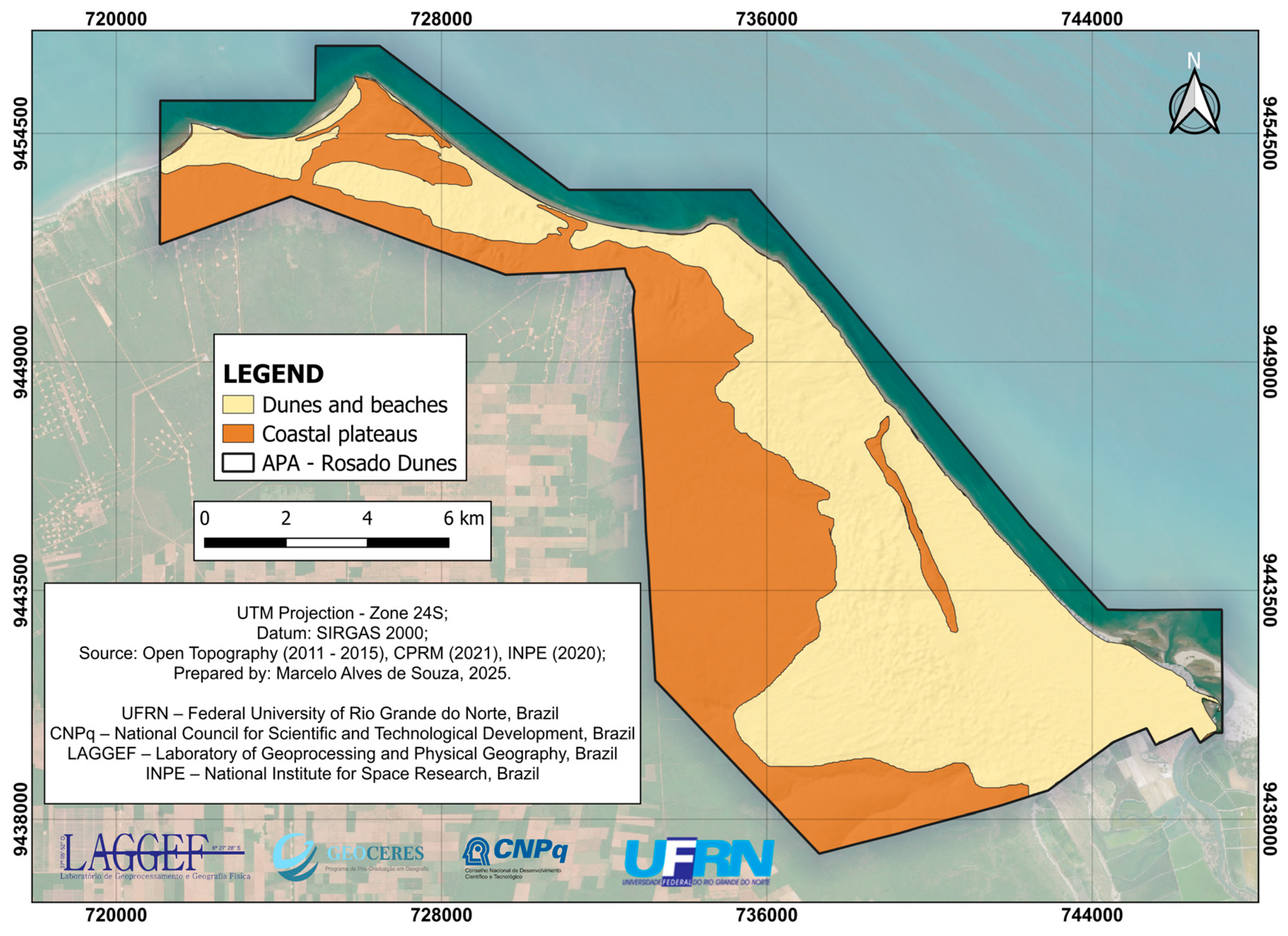

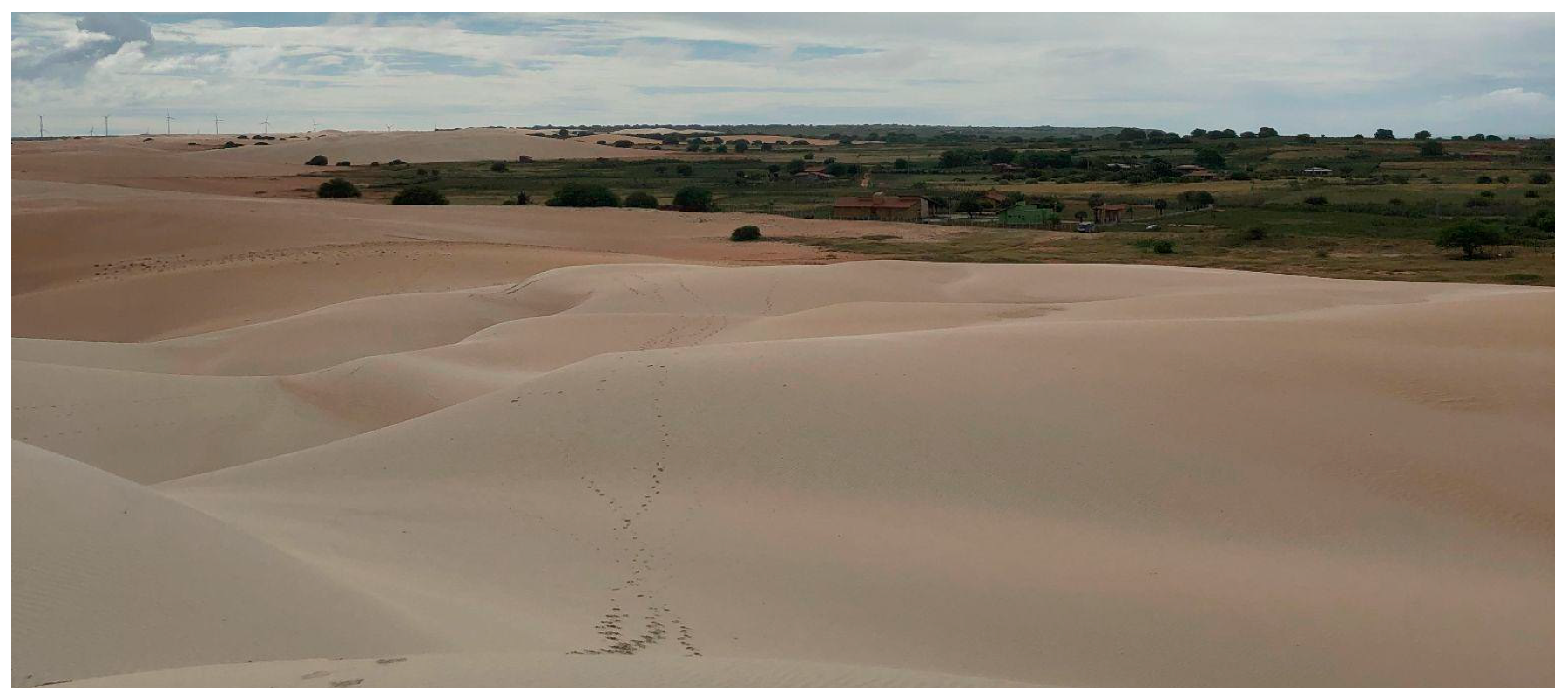
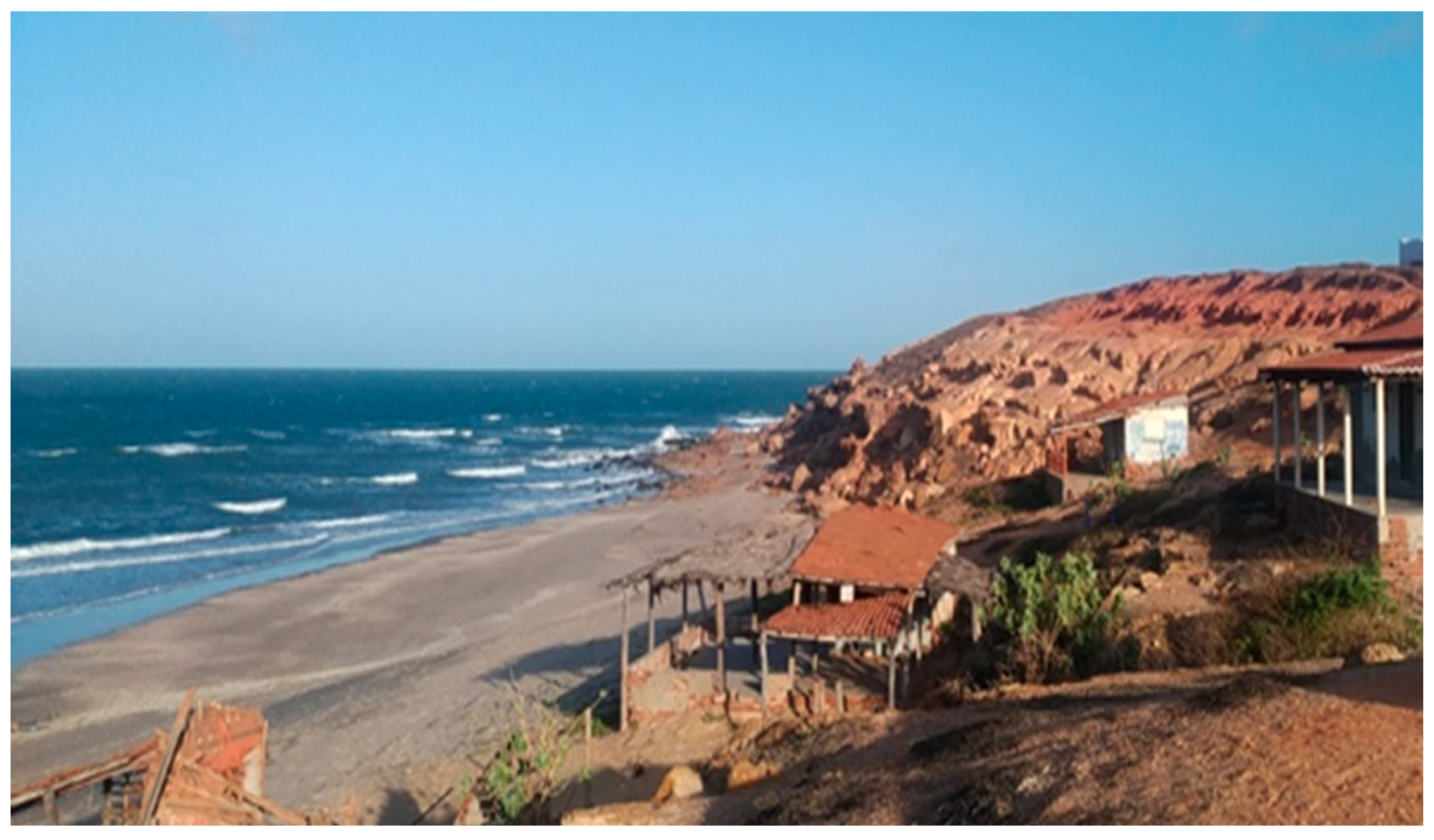

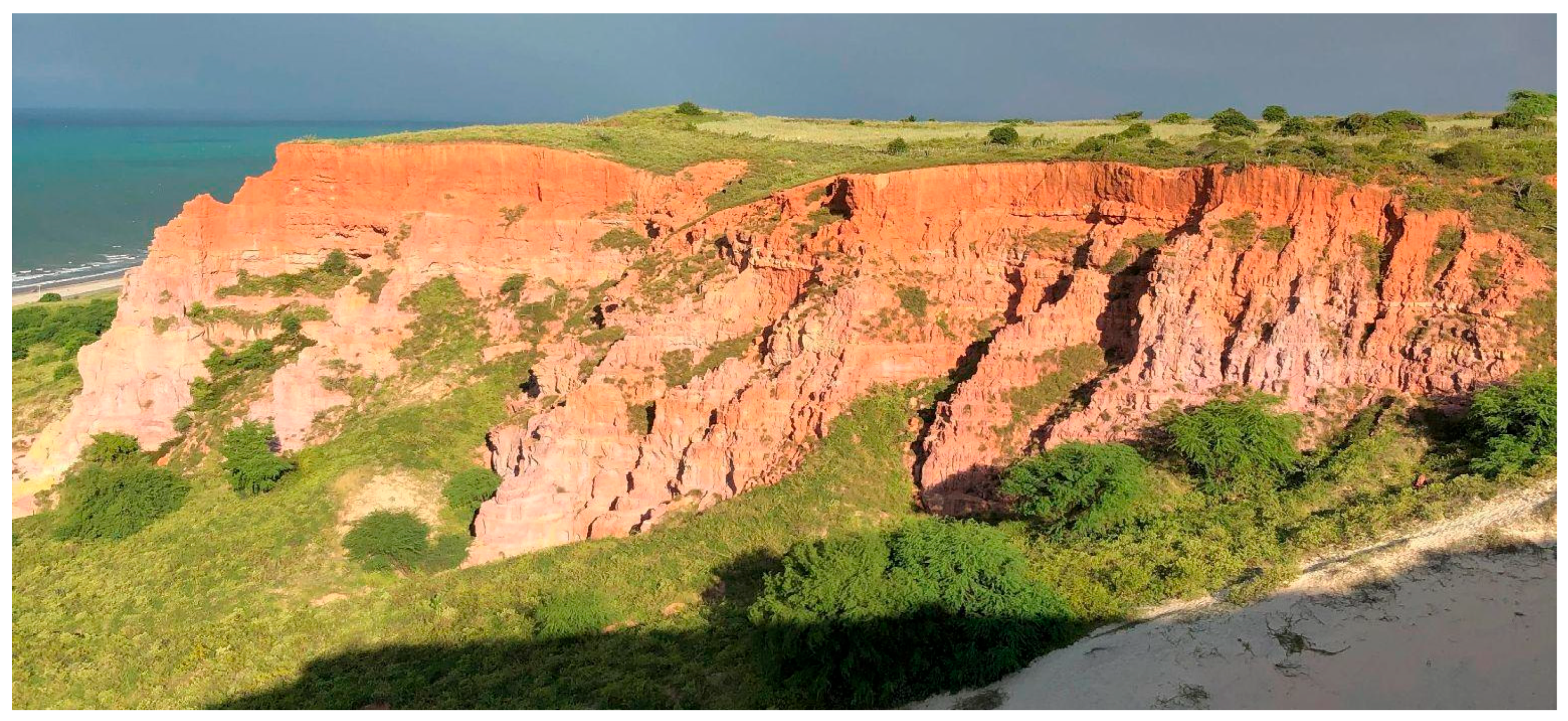
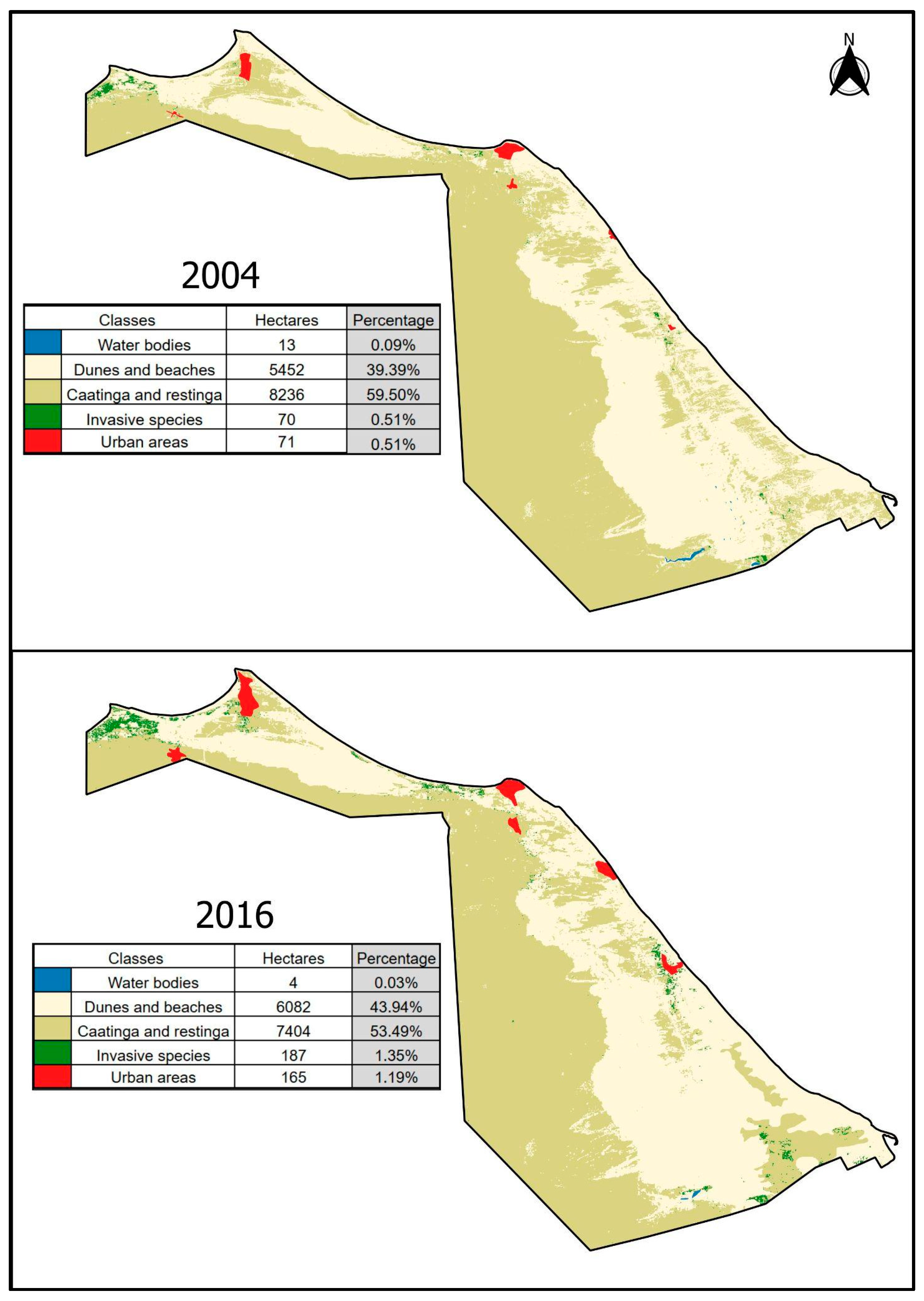
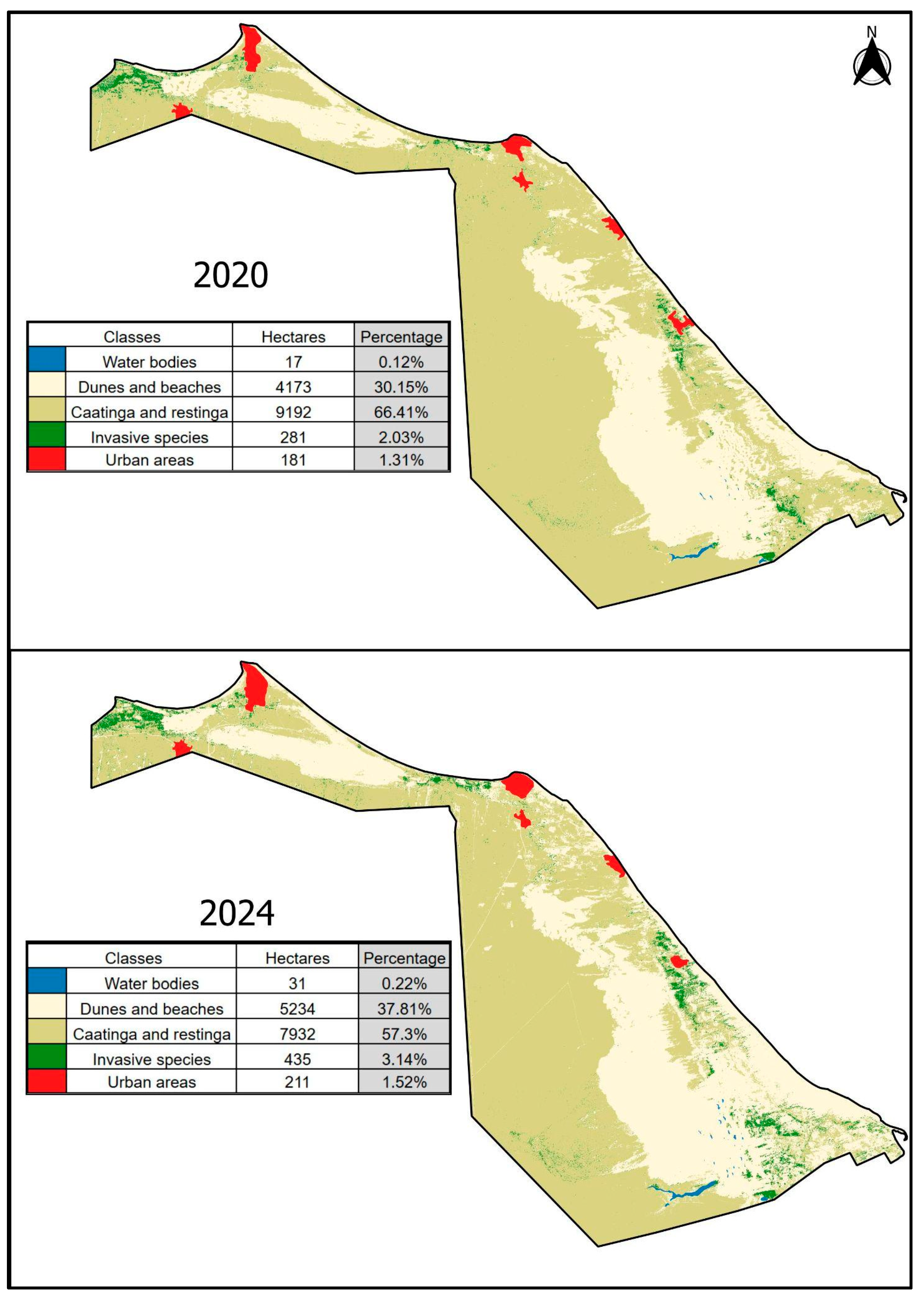
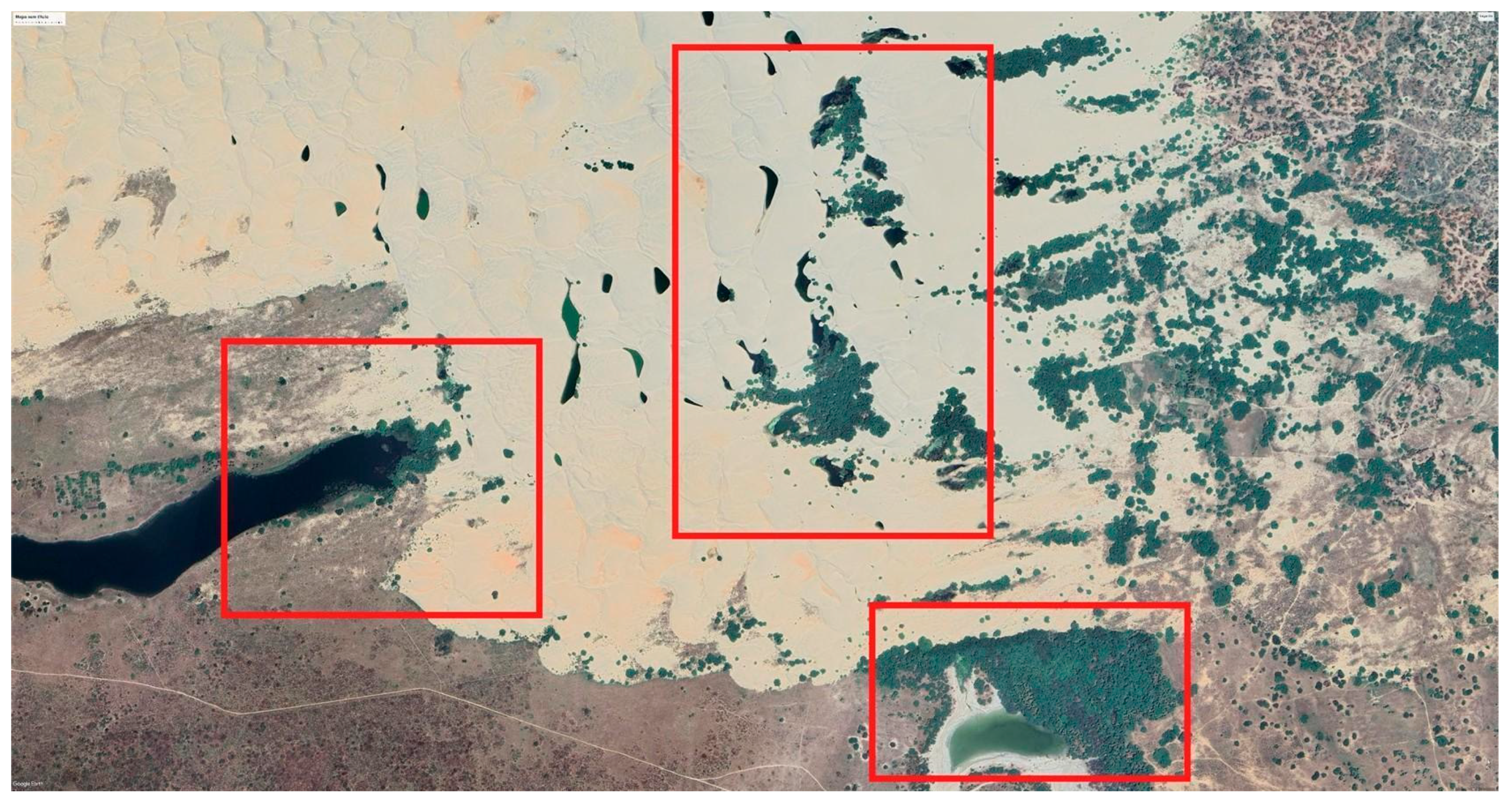



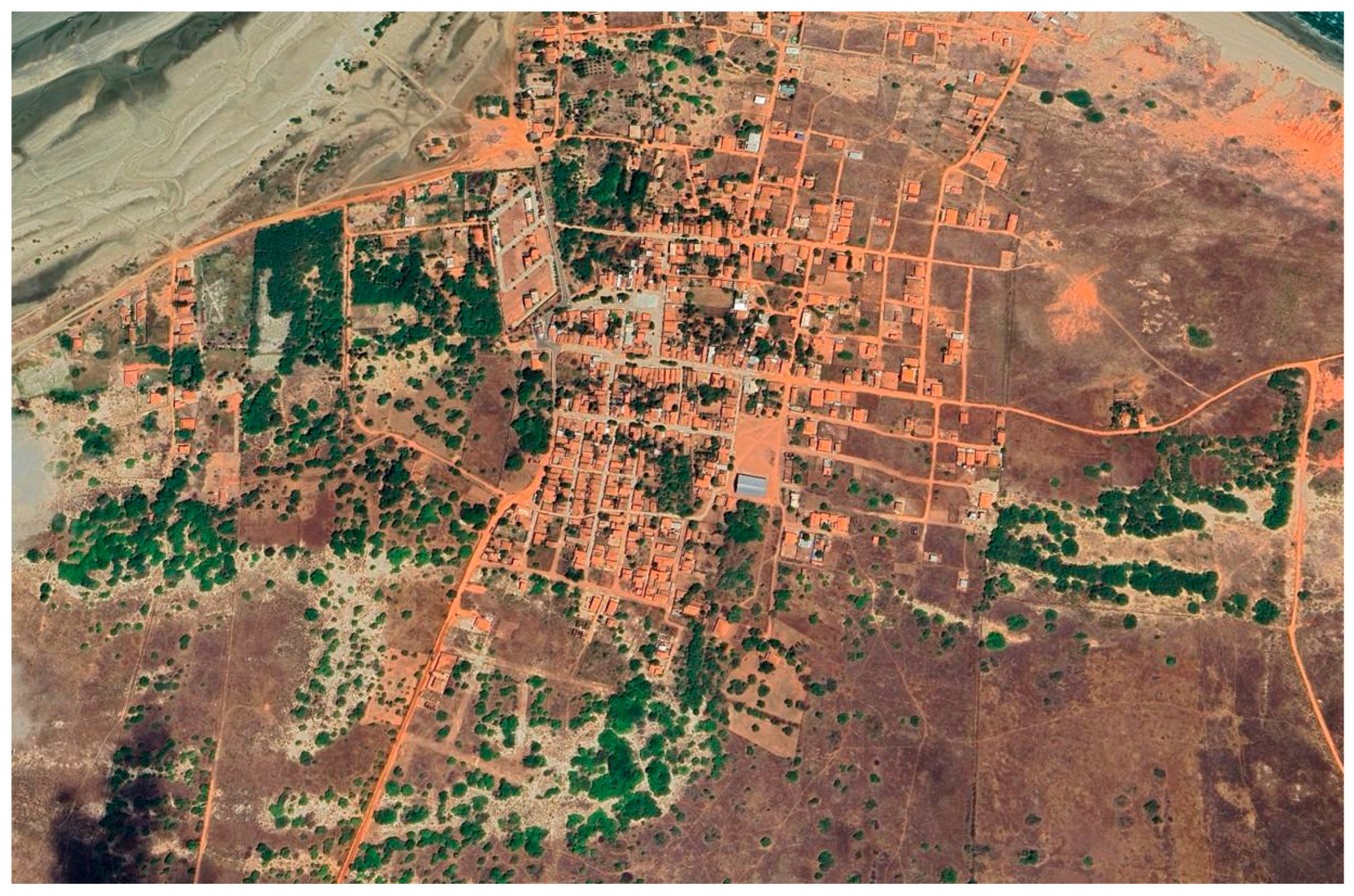
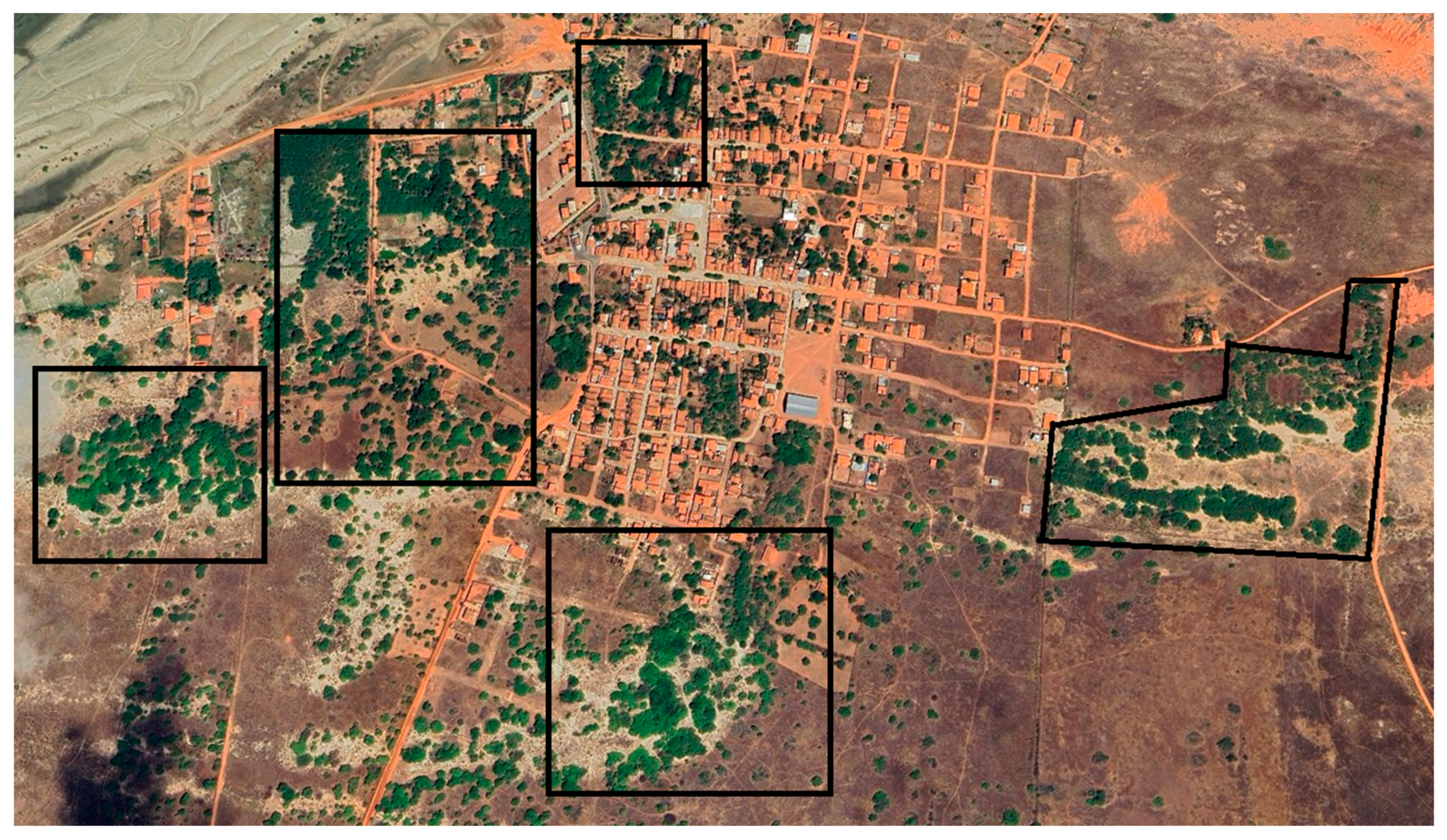
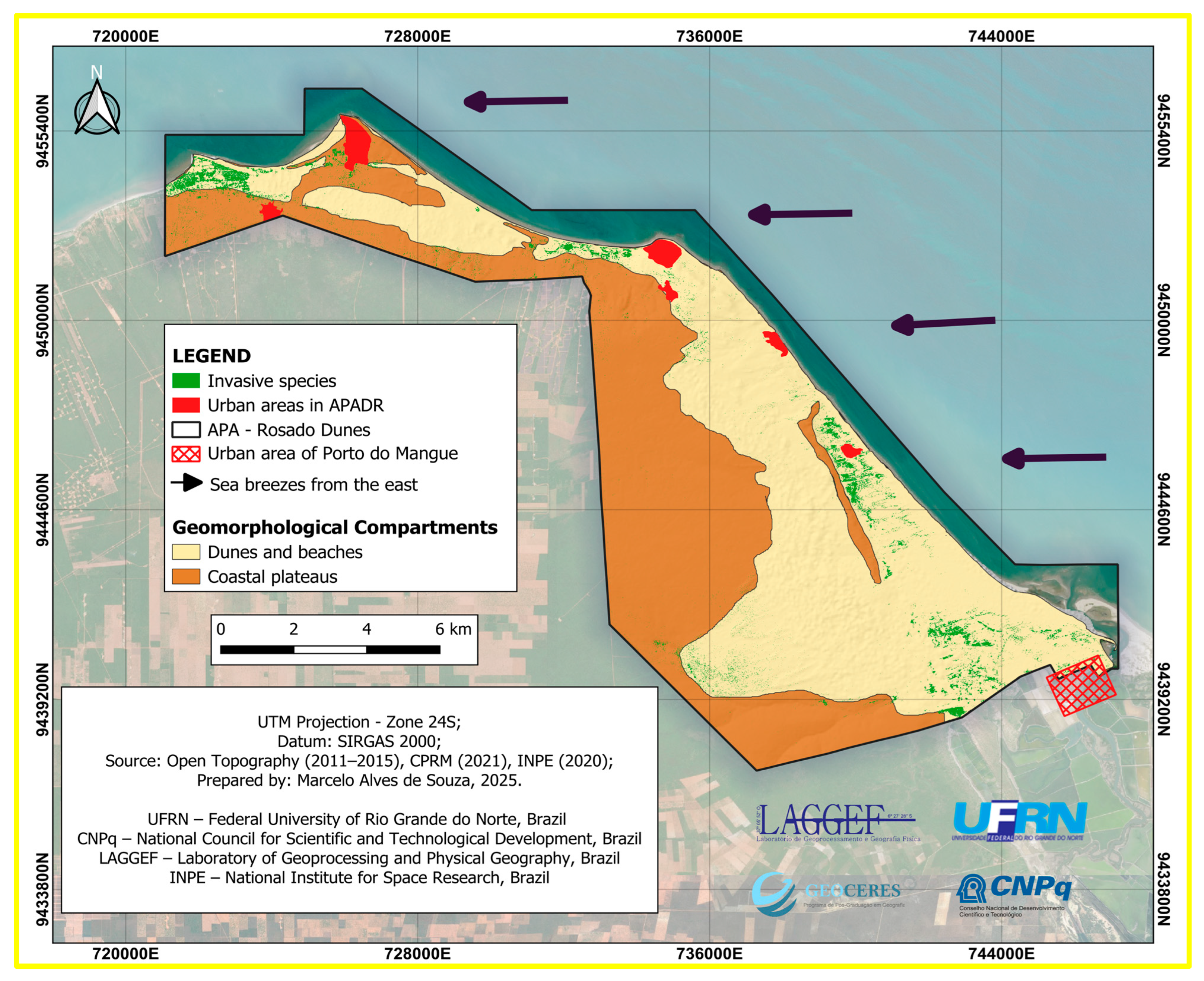


| Images | Satellite | Date | Sensor |
|---|---|---|---|
| 1 | SPOT 5PSM | 1 September 2004 | HRG |
| 2 | CBERS—4 | 15 September 2016 | MUX |
| 3 | CBERS—4A | 8 October 2020 | WPM |
| 4 | CBERS—4A | 4 October 2024 | WPM |
| Cenoário | Overall Accuracy (%) | Kappa Index |
|---|---|---|
| 2004 | 99.9954 | 0.9999 |
| 2016 | 98.2732 | 0.9584 |
| 2020 | 99.4360 | 0.9778 |
| 2024 | 99.7070 | 0.9899 |
| Geomorphological Compartments | Invasive Species | |
|---|---|---|
| Hectares | Percentage | |
| DUNES AND BEACHES | 360 | 83% |
| COASTAL PLATEAUS | 75 | 17% |
Disclaimer/Publisher’s Note: The statements, opinions and data contained in all publications are solely those of the individual author(s) and contributor(s) and not of MDPI and/or the editor(s). MDPI and/or the editor(s) disclaim responsibility for any injury to people or property resulting from any ideas, methods, instructions or products referred to in the content. |
© 2025 by the authors. Licensee MDPI, Basel, Switzerland. This article is an open access article distributed under the terms and conditions of the Creative Commons Attribution (CC BY) license (https://creativecommons.org/licenses/by/4.0/).
Share and Cite
Souza, M.A.d.; Santos, V.A.d.; Diniz, M.T.M.; Lopes, D.d.V.; dos Santos, J.Y.G.; Araújo, P.V.d.N. Assessment of Variation in Land Use/Land Cover (LULC) and Greening Through the Expansion of Algaroba (Neltuma juliflora) in the Semi-Arid Brazilian Coast. Geographies 2025, 5, 70. https://doi.org/10.3390/geographies5040070
Souza MAd, Santos VAd, Diniz MTM, Lopes DdV, dos Santos JYG, Araújo PVdN. Assessment of Variation in Land Use/Land Cover (LULC) and Greening Through the Expansion of Algaroba (Neltuma juliflora) in the Semi-Arid Brazilian Coast. Geographies. 2025; 5(4):70. https://doi.org/10.3390/geographies5040070
Chicago/Turabian StyleSouza, Marcelo Alves de, Vanderli Alves dos Santos, Marco Túlio Mendonça Diniz, Daví do Vale Lopes, José Yure Gomes dos Santos, and Paulo Victor do Nascimento Araújo. 2025. "Assessment of Variation in Land Use/Land Cover (LULC) and Greening Through the Expansion of Algaroba (Neltuma juliflora) in the Semi-Arid Brazilian Coast" Geographies 5, no. 4: 70. https://doi.org/10.3390/geographies5040070
APA StyleSouza, M. A. d., Santos, V. A. d., Diniz, M. T. M., Lopes, D. d. V., dos Santos, J. Y. G., & Araújo, P. V. d. N. (2025). Assessment of Variation in Land Use/Land Cover (LULC) and Greening Through the Expansion of Algaroba (Neltuma juliflora) in the Semi-Arid Brazilian Coast. Geographies, 5(4), 70. https://doi.org/10.3390/geographies5040070










